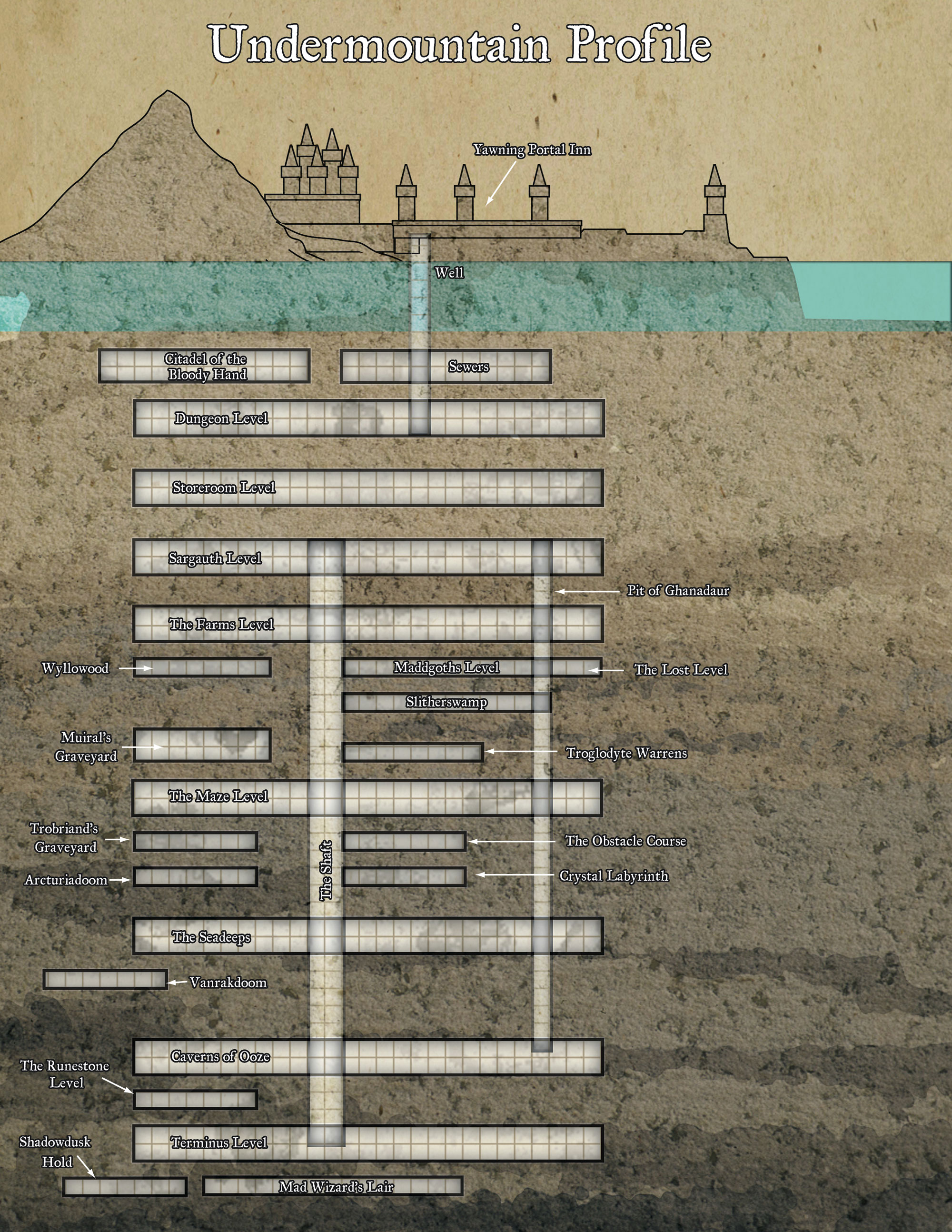transtemporal
Explorer
Oh, I was hoping for a single DC to defeat the Undermountain skill challenge. Something like "You roll a 20, you won Undermountain!" 


It sounds like people agree on the idea, but not on the very simple tables. I can see that. It's certainly too abstract in my initial version, I'd agree. Something that both [MENTION=20323]Quickleaf[/MENTION] and [MENTION=913]Schmoe[/MENTION] mention is bringing out the flavour more heavily; I wonder if bringing in a very limited element of mapping could help. I'm struggling to think of how to describe this.
Okay, so here is the grand map of Undermountain. From my understanding, only parts of this ever received full 5' squares maps; Dungeon, Storeroom, Sargauth for the main levels, and some of the random smaller parts.

As an example of the normal maps, here is the first level. Just so that we're all on the same page. This is the stuff that I'm trying to avoid.

Now, say that we use that first map as our basis. We can have three starting points, for current discussion - Yawning Portal, Sewers, Citadel (which is under the Castle, presumably for extra plot fruitiness). The party wants to get to a dungeon, and they have learned that it is on the first level. So we look at our special reference map thingy, and see that they'd pass through two zones - Entrance (whichever one they use), and 1st. Each of these could have specific events tables associated with them, and each require the Guide to make a roll to determine how many events were met, using multiple sub-tables as suggested. If, however, the party want to get to The Maze Level, and they've discovered The Shaft, then they would need to travel through six zones - Entrance, Dungeon, Storeroom, Sargauth, Shaft, Maze. Again, each comes with its (specific?) table of Stuff, including combat encounters, traps, portals (that might act as permanent shortcuts, so that the party can always in the future get from Dungeon to Maze without any intervening steps, for example).
If this was the method taken, I wonder if having discreet roles for party members at all is that helpful. You're already getting beyond the level of abstraction used in AiME or 4e Skill Challenges. Instead, it might be simpler to have "The Party" make a roll of 1d20+proficiency bonus to act as the Guide roll, and then have that prompt a number of events, each of which would be phrased like...
"One party member must make an DC20 Arcana check to decipher the runes on this door, or the party will be forced to return to the previous level and try to find another path."
"Two party members must make Athletics checks at DC10 to help cross a chasm; each failure will give one party member a level of Exhaustion, as they fall and must be retrieved."
Does this sound more... Undermountainy than the abstract method I proposed in the first post?
This does have the downside of requiring much more work to create the tables, but admittedly also the upside of not requiring them all to be made up front. Terminus Level's table doesn't need to be made until the party actually heads that far down, for example.
I think a schematic map of the various entrances (there are more than you list) plus the various major points might help. Or might not
What you might do (though I think you are trying to avoid this) is to have your tables have a chance of a random encounter (maybe a curtain of darkness, a gravity pit, or other UM trap, other NPC's (hostile or not) to help with the flavor.
What if you sort of broke the map down into "Hub" areas?
So, lets say the first level of Undermountain has four "zones". Library ruins, Ancient Tombs, A Beholder Lair, and a Pirate Den. You'd build each of those as six to seven room mini-dungeons, and then the Skill Challenge you talk about is what the PCs do to get from one Zone to another. And, based on what two zones they're closest to, that would affect the results on the random table?
I will say, though, that this definitely has the potential to turn into a fair amount of work. I would only do it if you and your players really want to move away from the literal mapping.
...
Ilbranteloth's 5e Version of Embarkation Roll
You (most likely the character with the highest score, possibly with help granting advantage) would make a Survival check against the Peril Rating (the usual DC table, the five steps from Easy to Nearly Impossible).
Success: Advantage on your Embarkation roll.
Failure: Standard Embarkation roll (1d12).
Failure by 5 or more: Disadvantage on your Embarkation roll.
Simple, and uses existing 5e mechanics. I might also expand the Embarkation table to 20 entries and just use a d20 instead of a d12, but it's really not that important.
You also wouldn't need to assign roles. I get that they are trying to add some flavor by assigning roles, but it seems like a pretty hefty restriction in light of the "anybody can try anything" approach of 5e and I think it's really kind of unnecessary.
...
